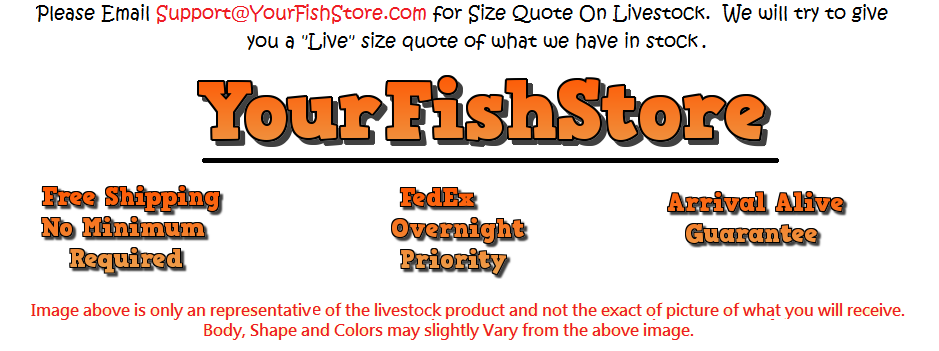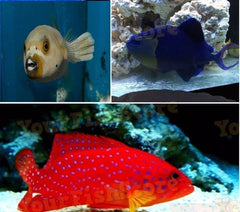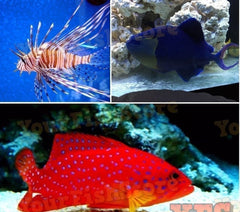x50 Florida Crawfish Package - Procambarus Alleni - Fresh Water Fish *BULK SAVE
Ebay
$ 201.54

x50 Florida Crawfish Package - Procambarus Alleni - Fresh Water Fish
Crayfish Stats
Minimum Tank Size: 10 - 50 Gallons
Care Level: Easy
Water Conditions: PH 6.5-8 and Medium Hard to Very Hard
Temperature: 65-75 F (18-23 C)
Maximum Size: 3 inches (8 centimetres)
Minimum Tank Size: 10 - 50 Gallons
Care Level: Easy
Water Conditions: PH 6.5-8 and Medium Hard to Very Hard
Temperature: 65-75 F (18-23 C)
Maximum Size: 3 inches (8 centimetres)
Setting Up a Crawfish Aquarium
Set up a 10- 50 gallon aquarium somewhere it will receive natural light and the water will remain at room temperature. The ideal water temperature for your crawfish depends on what species you have -- probably between 60 and 80 degrees F.
Fill the bottom of the aquarium with about 3 inches of aquarium gravel. Arrange the gravel so it has hills and valleys.
Add aquarium-safe stones and logs to the tank. Add items big enough that your crawfish can use them to hide. PVC pipe also works well as a hiding tunnel, as long as its diameter is big enough that the crawfish can easily walk through it. Make sure decorations aren't so close to the top of the tank that the crawfish could use them to escape.
Add a clear lid or mesh screen top to your aquarium to keep your crawfish from getting out. A regular tank hood with light isn't recommended because crawfish don't need or want too much light in their environment.
Add water to your aquarium until the water is at least 6 inches deep. Arrange the tank so that some of the elements protrude out of the water in case your crawfish wants to hang out on land for a bit.
Set up your filter. A hanging filter that pours a stream of water into the tank with the uptake submerged will produce a gentle water flow that benefits your crawfish.
Allow the filter to run for 24 hours before proceeding.
Caring for Your Crawfish
Float the bag or container containing your crawfish in the aquarium for 1 hour, allowing the water levels to acclimate. Then, release your crawfish into the aquarium.
Feed your crawfish once every other day. Wild crawfish are scavengers that eat plant material and dead animals. Your pet crawfish will happily eat lettuce, pieces of vegetable, algae-based foods and sinking shrimp or fish pellets. You can give your crawfish live feeder fish to eat. Some species will more readily hunt live prey than others. Make sure your crawfish gets plenty of calcium and iodine in his diet, which he needs to form a new shell after a molt. Specially formulated crustacean foods are designed to provide the nutrients needed for healthy molts.
Clean your crawfish's habitat regularly and perform partial water changes at least once a week. Take out about 25 percent of the water from the tank and replace it with dechlorinated water. Remove waste and leftover food from the tank by sucking it up with a turkey baster.
Set up a 10- 50 gallon aquarium somewhere it will receive natural light and the water will remain at room temperature. The ideal water temperature for your crawfish depends on what species you have -- probably between 60 and 80 degrees F.
Fill the bottom of the aquarium with about 3 inches of aquarium gravel. Arrange the gravel so it has hills and valleys.
Add aquarium-safe stones and logs to the tank. Add items big enough that your crawfish can use them to hide. PVC pipe also works well as a hiding tunnel, as long as its diameter is big enough that the crawfish can easily walk through it. Make sure decorations aren't so close to the top of the tank that the crawfish could use them to escape.
Add a clear lid or mesh screen top to your aquarium to keep your crawfish from getting out. A regular tank hood with light isn't recommended because crawfish don't need or want too much light in their environment.
Add water to your aquarium until the water is at least 6 inches deep. Arrange the tank so that some of the elements protrude out of the water in case your crawfish wants to hang out on land for a bit.
Set up your filter. A hanging filter that pours a stream of water into the tank with the uptake submerged will produce a gentle water flow that benefits your crawfish.
Allow the filter to run for 24 hours before proceeding.
Caring for Your Crawfish
Float the bag or container containing your crawfish in the aquarium for 1 hour, allowing the water levels to acclimate. Then, release your crawfish into the aquarium.
Feed your crawfish once every other day. Wild crawfish are scavengers that eat plant material and dead animals. Your pet crawfish will happily eat lettuce, pieces of vegetable, algae-based foods and sinking shrimp or fish pellets. You can give your crawfish live feeder fish to eat. Some species will more readily hunt live prey than others. Make sure your crawfish gets plenty of calcium and iodine in his diet, which he needs to form a new shell after a molt. Specially formulated crustacean foods are designed to provide the nutrients needed for healthy molts.
Clean your crawfish's habitat regularly and perform partial water changes at least once a week. Take out about 25 percent of the water from the tank and replace it with dechlorinated water. Remove waste and leftover food from the tank by sucking it up with a turkey baster.


Quick Supply Links - $3.99 Shipping On All Supplies
Protein Skimmers - Lights - Fish Food - Pumps - Aquariums - Chillers - Decorations - Food - Filters - Medication - Nets - Salt - Substrate - Sump Tanks - UV Sterlizers - Cleaning Supplies - Nets - Koi Nets - Substrate - CO2 - Coral Viewers

Ebay Livestock & Supplies
QUESTIONS & ANSWERS
Have a Question?
Be the first to ask a question about this.














